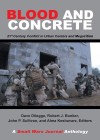Blood and Concrete: 21st Century Conflict in Urban Centers and Megacities
Edited by Dave Dilegge, Robert J Bunker, John P Sullivan and Alma Keshavarz
Small Wars Foundation, 2019,
ISBN 9781984573759, 705pp
Reviewed by: Lieutenant Colonel Dayton McCarthy
Positioning itself to capture the burgeoning interest in cities and how armies might interact with and within them, Blood and Concrete is a compendium of over 50 short articles on various aspects of urban warfare that have appeared on the Small Wars Journal website. And some of these articles are very short: a handful are one to two pages long. Herein lies a major problem with many of the articles in the book. Their length, while digestible, results often in a superficial treatment of the subject matter. Moreover, many of the articles suffer from the problem common to some blogs and online articles: a lack of depth and academic objectivity, replaced instead by a superficial treatment of the subject matter coupled with urgent recommendations (‘the Army must buy/do/train for …’) that are often devoid of context or other aspects of the connected ‘big picture’.
The four editors of Blood and Concrete could have been more selective: a number of articles say much the same thing in much the same way. The book also illustrates the dangers of simply compiling a series of independently written articles without overarching editorial guidance. The reader will quickly tire of reading the same facts in successive articles about rates of urbanisation, growth of megacities and other relatively well-known tropes; surely these did not need to be repeated in every article.
These gripes aside, Blood and Concrete contains some great pieces of work that cover such wide-ranging topics as the Mumbai siege and London riots, the distorted visions of ‘narco-cities’ in Mexico and microclimates in dense urban terrain. A number of articles cover the intelligence preparation of the battlespace (IPB) as it relates to cities and urban terrain. In ‘A Proposed Framework for Appreciating Megacities’ the authors argue that each city must be understood through the components of context, scale, density (physical, demographic and informational), connectedness and flow (that is, the movement of people, resources or things in and out of a city). Another article, ‘City as a System Analytical Framework’, spruiks a private consultancy’s proprietary analytical tool to understand the connections between—and thus ramifications of—the elements of the ‘urban triad’ of population, infrastructure and physical environment of a city.
In my opinion, the last half-dozen articles stand out, as if the editors left the best for last. ‘Complex Cyber Terrain in Hyper-Connected Urban Areas’ and ‘Cyber Operational Considerations in Dense Urban Terrain’ make for a sobering primer on the all-pervasive informational/cyber domain within dense urban areas. Even the poorest of cities will be hyper-connected, generating not only an Internet of Things but also an Internet of People that seamlessly exchanges information about individuals, their social context and their environment.
Household names such Robert Muggah and Russell W Glenn conclude the book with insights that bring many of the themes together, weaving in nascent concepts such as multi-domain battle (MDB) for good measure. Glenn argues that urban operations and MDB emphasise the need for distributed, mission command oriented forces. As an MDB agnostic, I am not so sure; in fact many of the preceding articles suggest that to operate successfully in cities a panoply of enablers will be required that are more likely to be held at a higher, centralised level of command than allocated out to subordinate units.
The editors intended Blood and Concrete to be a ‘foundation for understanding urban operations and sustaining urban warfare research’. This hefty tome achieves this—but with more rigorous and robust editing, it might have done so in a volume half the size.

